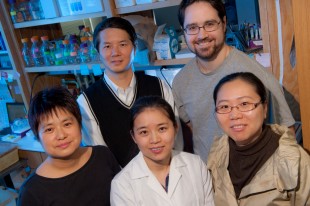CONTACTS:
David Ruth Jade Boyd Gracie Gutierrez
Rice University Rice University Baylor College of Medicine
National Media Director Science Editor Senior Communication Specialist
713-348-6327 713-348-6778 713-798-4710
druth@rice.edu jadeboyd@rice.edu ggutierr@bcm.edu
Cancer epigenetics: breakthrough in ID’ing target genes
CPRIT grant helps Rice, BCM crack problem of predicting gene targets for PcG proteins
HOUSTON — (March 13, 2012) — Cancer is usually attributed to faulty genes, but growing evidence from the field of cancer epigenetics indicates a key role for the gene “silencing” proteins that stably turn genes off inside the cell nucleus. A new study from Rice University and Baylor College of Medicine (BCM) promises to speed research in the field by rapidly identifying the genes that epigenetic proteins can target for silencing.
The study, which appears this week in Nucleic Acids Research, shows how a new computer program called EpiPredictor can search any genome to identify specific genes affected by epigenetic proteins. The research includes detailed experimental findings that verify EpiPredictor’s results. The research was funded in part by the Cancer Prevention Research Institute of Texas (CPRIT).

In work that could shed light on the molecular workings of cancer cells, researchers from Rice University and Baylor College of Medicine have developed a method to rapidly identify genes that can be targeted for silencing. The team includes (clockwise from left) Qinghua Wang, Jianpeng Ma, Brian Kirk, Jia Zeng and Yufeng Gou.
“Cancer epigenetics is a new field, and we are still struggling with the basics,” said lead investigator Jianpeng Ma, professor of bioengineering at Rice and the Lodwick T. Bolin Professor of Biochemistry at BCM. “It’s something like a board game. Until now, we’ve understood some of the rules and seen a few of the pieces, but the game board itself has been mostly blank. EpiPredictor lets everyone see the board. It really changes things.”
While many cancers have been linked to mutations in the DNA sequence of particular genes, epigenetic changes do not involve genetic mutations. Instead, epigenetics allows two cells with identical DNA sequences to behave in wholly different ways. Epigenetic proteins effectively edit the genome by turning off genes that are not needed. This editing process is what allows human beings to have specialized cells — like nerve cells, bone cells and blood cells — that look and behave differently, even though they share the same DNA.
The key epigenetic players in cancer are a family of proteins called polycomb-group (PcG) proteins. PcGs are found deep inside the nucleus of cells, in the chamber where DNA is stored. Studies have found abnormally high levels of PcGs in some of the most aggressive forms of breast and prostate cancer.
PcGs are generalists that can be called upon to silence any one of several hundred to several thousand genes. They are recruited to this task by polycomb response elements (PREs), segments of DNA that are located next to the genes the proteins subsequently silence. This is where the playing board goes blank; though scientists know there are literally hundreds to thousands of potential PREs in any given genome — including everything from simple insects to human beings — only a few PREs have ever been found.
“So far, only two PREs have been experimentally verified in mammals — one in mice and one in humans,” said EpiPredictor creator Jia Zeng, a BCM postdoctoral research associate. “We suspect there are so many of them, but finding them has been difficult.”
Zeng, a computer scientist, had no formal biology training when she joined Ma’s laboratory under a CPRIT-funded training program for computational cancer research.
“One of the biggest challenges since the completion of the Human Genome Project has been how to dig useful information out of the enormous amount of genomic data,” Ma said.
Ma said Zeng’s new method for zeroing in on PRE sequences is broadly applicable for genomic data mining in areas beyond cancer research.
“Determining the function of a gene based solely on sequence data is virtually impossible,” Ma said. “Recognizing this, Jia applied some advanced tools from computer science to create a learning program that could be trained to look for PRE sequences based upon the scant experimental data that were available.”
In tests on the genome of the fruit fly Drosphilia melanogaster, the EpiPredictor program found almost 300 epigenetic target genes. Experimental research by Ma’s longtime collaborator, BCM biochemist Qinghua Wang, verified that the EpiPredictor predictions were biologically significant.
“We are now working on using the method to scan the human genome to search for potential genes that play a role in cancer epigenetics,” said Wang, assistant professor of biochemistry and molecular biology. “We also hope that others will explore how this new method may help to identify the location and function of genes beyond the realm of epigenetics.”
Co-authors include Rice graduate students Yufeng Gou and Brian Kirk, a predoctoral training fellow in the National Library of Medicine Training Program of the Keck Center of the Gulf Coast Consortia. The research was supported by the National Institutes of Health, the National Science Foundation, the Welch Foundation and the John and Ann Doerr Fund for Computational Biomedicine at the Ken Kennedy Institute for Information Technology, Rice University. Zeng’s CPRIT fellowship is administered by the Keck Center Computational Cancer Biology Training Program of the Gulf Coast Consortia.
-30-
A high-resolution image is available for download at:
https://news2.rice.edu/files/2012/03/0301_MA.jpg
CAPTION: In work that could shed light on the molecular workings of cancer cells, researchers from Rice University and Baylor College of Medicine have developed a method to rapidly identify genes that can be targeted for silencing. The team includes (clockwise from left) Qinghua Wang, Jianpeng Ma, Brian Kirk, Jia Zeng and Yufeng Gou.
CREDIT: Jeff Fitlow/Rice University
A copy of the Nucleic Acids Research paper is available at:
http://nar.oxfordjournals.org/content/early/2012/03/12/nar.gks209.full
Located on a 300-acre forested campus in Houston, Rice University is consistently ranked among the nation’s top 20 universities by U.S. News & World Report. Rice has highly respected schools of Architecture, Business, Continuing Studies, Engineering, Humanities, Music, Natural Sciences and Social Sciences and is known for its “unconventional wisdom.” With 3,708 undergraduates and 2,374 graduate students, Rice’s undergraduate student-to-faculty ratio is 6-to-1. Its residential college system builds close-knit communities and lifelong friendships, just one reason why Rice has been ranked No. 1 for best quality of life multiple times by the Princeton Review and No. 4 for “best value” among private universities by Kiplinger’s Personal Finance. To read “What they’re saying about Rice,” go to www.rice.edu/nationalmedia/Rice.pdf.



